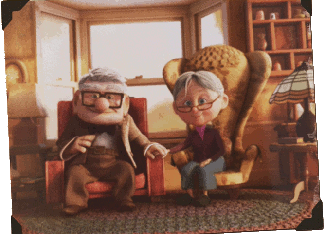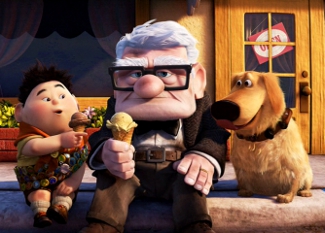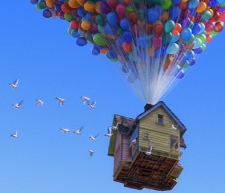Generally, the best children’s films manage to entertain adults as much as their younger target audiences, a blessing for parents forced to watch the latest blockbuster animated movie with their kids ad nauseam. Outside of Japan, Pixar Animation Studios has proven the most successful at striking that delicate balance, consistently crafting family films with rich themes and sly references that appeal to jaded grownups while delivering enough fun and excitement to distract wide-eyed children for at least ninety minutes.
At times, Pixar’s 2009 film, Up, feels more like a movie made for adults, with bright colors, action sequences, and even talking animals to appease the children who won’t understand why Mommy or Daddy is sniffling in the seat next to them. Though it doesn’t quite deliver the emotional punch of Studio Ghibli’s masterpiece Grave of the Fireflies, it is a deeply affecting story that broke more than a few hearts, probably several times during the course of the film.
Carl and Ellie meet as young children, united by their common idolization of explorer Charles Muntz and his dirigible, Spirit of Adventure. Carl is a timid, quiet boy in glasses, but Ellie speaks constantly and loudly. She shows him her Adventure Book, a scrapbook of newspaper clippings about Muntz, and shares her dream with him: to put her clubhouse at the top of Paradise Falls in South America, which she explains is “like America, but south.” Inspired by Carl’s blue helium balloon (with “Spirit of Adventure” scrawled across it), she comes up with a plan. “You can take us there in a blimp! Swear you’ll take us! Cross your heart. Cross it! Cross your heart!” He does.
When they’re older they make another promise to each other—the two of them marry, and the Fredricksens’ many happy years roll past in a cheerful montage. They buy the old house Ellie used to pretend was her Explorers’ clubhouse, fix and decorate it, and go on idyllic picnics together. They both find jobs at a zoo, where Carl runs a balloon cart and Ellie takes care of animals. This is the kind of loving couple that holds hands while they read side-by-side in their favorite armchairs. They paint a nursery when they decide to have children, then learn the devastating news that Ellie can’t get pregnant.
To cheer his wife up, Carl reminds her of their childhood plan to go to Paradise Falls, and they start collecting spare change in a jar for the trip. But real life intervenes, as it does, and they frequently must raid their funds to pay for car tires, house repairs, and hospital bills. The years pass and eventually their dream is forgotten, until Carl, now an old man, decides to make good on his first promise to Ellie. He buys them plane tickets to Venezuela, but before he can surprise her with them, Ellie collapses and soon dies.
 This would be a sad end to many stories, but it’s just the beginning of this one. Old and alone, Carl (Ed Asner) is set in his daily routine and fiercely protective of his house, which he talks to as if it were Ellie. He refuses to sell to developers who are tearing down the neighborhood to build stores like Lazer Tan and Sushi Pronto, but when he hits one of the construction workers with his cane, the court rules him a public menace. He’s ordered to move to the Shady Oaks retirement home. “What do I do now, Ellie?” he asks. While packing, he finds her old Adventure Book in a closet, remembers their dream, and comes up with a solution: if he has to leave, he’s taking his house with him.
This would be a sad end to many stories, but it’s just the beginning of this one. Old and alone, Carl (Ed Asner) is set in his daily routine and fiercely protective of his house, which he talks to as if it were Ellie. He refuses to sell to developers who are tearing down the neighborhood to build stores like Lazer Tan and Sushi Pronto, but when he hits one of the construction workers with his cane, the court rules him a public menace. He’s ordered to move to the Shady Oaks retirement home. “What do I do now, Ellie?” he asks. While packing, he finds her old Adventure Book in a closet, remembers their dream, and comes up with a solution: if he has to leave, he’s taking his house with him.
When workers from Shady Oaks arrive to pick him up the next morning, they’re surprised to see a massive canopy of balloons rise above the house, tearing it from its foundation and lifting it into the sky. Carl uses homemade sails and rigging to steer the ship through and over the city, heading due south for Paradise Falls. “We’re on our way, Ellie,” he says, then kisses her picture.
Carl sits down in his armchair to enjoy the ride. Then he hears a knock at the door. He opens it and finds Russell (Jordan Nagai), a young Wilderness Explorer, clinging to the wall on his porch. “Please let me in,” the terrified boy says. Carl eventually allows him inside and Russell’s fear instantly turns to childish fascination and curiosity. “I’ve never been in a floating house before,” he says.
Carl resigns himself to bringing the boy home, but before he can take the house down, it’s caught in a violent storm. He rushes around trying to save his tumbling possessions from destruction, especially the collection jar and his photograph of Ellie. When he awakens the next morning, he discovers that Russell has guided them to Venezuela with the help of his Wilderness Explorer GPS. They descend into the mist and narrowly miss colliding with rock columns before setting down on a plateau across from Paradise Falls. Carl decides to walk the floating house over to the waterfall “like a parade balloon,” tethered by a garden hose, and Russell offers to help; if he gets his “Assisting the Elderly” merit badge, he hopes his absentee father will come to his Senior Wilderness Explorer ceremony. They’re on a tight timetable, though—they only have three days before the helium will leak from the balloons.
This odd couple is soon joined by Kevin (Pete Docter, who also co-directed and co-wrote the film, and directed Pixar’s Monsters, Inc), a large native bird with a fondness for chocolate, and Dug (Bob Petersen, co-director and co-writer), a talking golden retriever trying to take the bird prisoner. Carl ends up involved in a lot more than he bargained for when Russell insists that they help Kevin (who turns out to be female) return to her babies. The group is captured by a pack of dogs tracking her and brought to the legendary explorer Charles Muntz (Christopher Plummer). At first they are welcomed as guests, but things take a sinister turn when the obsessive man suspects them of poaching his quarry: “You know, Carl, these people who crash through here all tell pretty good stories. A surveyor making a map… a botanist cataloging plants… An old man taking his house to Paradise Falls. Oh, that’s the best one yet. I can’t wait to hear how it ends.” Carl’s is thrilled to meet his childhood hero, but conflicted when he realizes he has to protect Kevin from becoming part of Muntz’s collection.
Many of Pixar’s other films explore themes that may resonate more with an older audience than with kids, especially works like Finding Nemo, The Incredibles, Cars, and Wall*E. These animated features clearly work on some level for children, but much will go over their heads not only until they’re more mature but have also experienced the crises of parenthood, middle age, love, or loss. No surprise that the adult filmmakers might be interested in nostalgically reminiscing about the lost past or facing their fears about raising children or becoming obsolete, but kids (and Hollywood) are generally satisfied with much simpler fare. Still, as sophisticated as Pixar’s stories have been in the past, few were expecting the love story between Carl and Ellie to end so tragically only twelve minutes in.
 The comedic elements (and this is a very funny film, especially if you like dogs) and light action help to balance the heavier emotional weight of Carl’s grief. Some might criticize the obvious attempt to manipulate viewers’ feelings and or believe that it’s jarring in a kid’s movie, but this is probably the most honest and real of Pixar’s films to date. Life is full of joy and sadness, plans and difficulties, expectations and disappointment—ups and downs. The key is getting through it all and enjoying what you have. Up is aptly named both for the obvious imagery and plot contrivance of a flying house, and its raising of spirits. Carl is as down as one can get, and it’s only by Russell’s intervention and their shared experiences with Kevin and Dug that he can ultimately find happiness without the love of his life.
The comedic elements (and this is a very funny film, especially if you like dogs) and light action help to balance the heavier emotional weight of Carl’s grief. Some might criticize the obvious attempt to manipulate viewers’ feelings and or believe that it’s jarring in a kid’s movie, but this is probably the most honest and real of Pixar’s films to date. Life is full of joy and sadness, plans and difficulties, expectations and disappointment—ups and downs. The key is getting through it all and enjoying what you have. Up is aptly named both for the obvious imagery and plot contrivance of a flying house, and its raising of spirits. Carl is as down as one can get, and it’s only by Russell’s intervention and their shared experiences with Kevin and Dug that he can ultimately find happiness without the love of his life.
Russell is clearly a replacement for Ellie in Carl’s life. Not only does the talkative boy echo some of her mannerisms, but he even repeats her words when he asks Carl, “Promise we won’t leave (Kevin)? Cross your heart.” The comparison is more literally drawn when Carl drapes Russell’s Wilderness Explorer sash over the arm of her chair as he looks through her Adventure Book, and the substitution is complete when Carl pins the bottle cap Ellie gave him to Russell. When Carl was a boy, he needed Ellie to show him how to live and turn his life into an adventure; now as an old man, he needs someone like her to remind him of what’s good in life and give him a new adventure. Speaking with the wisdom of a child, Russell relates the following about his father:
He’s really good at camping, and how to make fire from rocks and stuff. He used to come to all my sweat lodge meetings. And afterwards we’d go get ice cream at Fentons. I always get chocolate and he gets butter brickle. Then we sit on this one curb right outside and I’ll count all the blue cars and he counts all the red ones. And whoever gets the most wins… I like that curb. It might sound boring, but I think the boring stuff is the stuff I remember the most.
There’s no moral here for children, and Russell doesn’t learn a lesson—he’s the one who teaches it. Ellie drives the point home when she speaks from beyond the grave via a previously unnoticed note to Carl in her Adventure Book: Thanks for the adventure—now go have a new one! Love, Ellie. Carl discovers for the first time that she has filled her Adventure Book with pictures of them, their wedding photo and mundane moments we all take for granted from time to time. Paradise Falls was their dream, but the life they shared was the adventure. All he needed was a reminder of what they had to realize what’s missing now, and this lets him finally literally let go of his baggage to save Russell, Kevin, and Dug—to make his house lighter, he tosses out everything that wasn’t nailed down, all the furniture and knick knacks that were all he had left of his wife. The only sentimental touch is carefully setting his and Ellie’s armchairs side by side atop the waterfall.
Without this epiphany that his house is “just a house,” Carl risks succumbing to the same obsession that kept Muntz hunting his bird for all these years. Instead of watching life go by from his porch as Carl did every day following Ellie’s death, he has to get out there and enjoy the “boring stuff,” like sitting on a curb and eating ice cream with Russell. It’s a simple lesson but an important one; it’s so obvious, it’s often forgotten or ignored.
Despite its somber subject matter, the film also never fails to entertain, with thrilling action sequences (Aerial combat! Jungle chases! Airships!) and stunning animation, loaded with a bright palette and breathtaking landscapes. The house truly looks lighter than air (classic cartoon physics are at work here, as taught at Acme Looniversity), and the renderings of cloth and textures are particularly detailed. Though released theatrically in 3-D, you don’t need a gimmick and a pair of glasses to appreciate the beauty of this film. This movie is more visual than most animations. With its stirring musical score, it often tells more of the story than is conveyed in dialogue, most notably the silent sequence that opens the film and gives us the essence of Carl and Ellie.
The plotting is also fairly tight. The opening “Spotlight on Adventure” movie, evoking the old Movietone film reels of the 1930s, both sets the tone and delivers some important background on Muntz and his dogs that some viewers may forget by the time they reappear more than halfway through the movie. The jokes are usually clever and subtle, with much of the comedy relying on dog humor and fortunately very little centering on how funny old people are. It’s satisfying that this film isn’t concerned with Carl’s aging, but his emotional detachment from life and the people around him.
Up is also notable because it’s the first Pixar film to feature an Asian American protagonist, authentically-voiced by Japanese-American Nagai. Though this doesn’t affect the plot, it’s a nice detail. As a Korean-American, honestly I’ve never given much thought to the portrayal of Asian Americans in cinema, but when I saw Russell I realized how infrequently they appear in the fiction I enjoy. I hope this is a sign we’ll see a better representation of diverse races not just in Pixar films but in all media.
Simply put, Up is a great film, not just a great animated film. It has something new for viewers each time they see it, and should definitely be revisited from time to time as we all grow up and grow older, so we remember to take a look around us and enjoy the small adventures we all experience every day.

Eugene Myers isn’t ashamed to admit that cartoons often make him cry.










